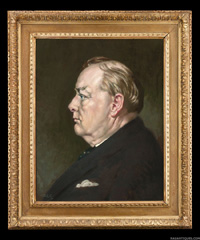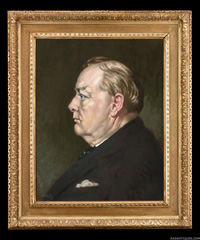
Churchill in the News
“Profile for Victory” Portrait of Churchill by A.E. Cooper for Sale

May 17, 2011
Alfred Egerton Cooper 1883-1974 • British
“Profile for Victory” Portrait of Sir Winston Churchill (1874-1965)
 Signed ” AEC” (lower left) and signed verso “19 WSC 42 / by AEC”
Signed ” AEC” (lower left) and signed verso “19 WSC 42 / by AEC”
Oil on canvas
Canvas: 20 1/16″ high x 16 3/8″ wide
Frame: 26 1/2″ high x 22 3/8″ wide

2024 International Churchill Conference
One of the most famous portraits ever painted of one of history’s most recognizable figures, this starkly realistic portrait of Sir Winston Churchill by Alfred Egerton Cooper depicts the pugnacious statesman in 1942, during the dark, early days of World War II. In what would become the famed Profile for Victory portrait, Cooper deftly captures Churchill’s legendary stubborn tenacity in the face of terrible odds in this oil on canvas. As Churchill was almost certainly Britain’s greatest inspiration during this time, the painting was reproduced after its exhibition at the Royal Academy in 1943 as a successful propaganda poster. It also bears the distinction of being one of the very few portraits painted of the prime minister during the Second World War. Many well-respected artists have painted Churchill, but Cooper bears the honor of having painted him more than anyone else. Cooper enjoyed a jovial relationship with the great man, and perhaps consequently, this portrait is known to be one of Churchill’s favorites.
At the time of this painting, Alfred Egerton Cooper was an internationally acclaimed portraitist. He was both ambitious and technically gifted, and his realistic style imparted a strong sense of glamour to European royalty, Buckingham Palace, the British Parliament and rich and powerful public figures who frequently sat for him. All of this did nothing, however, to further his chances of getting Churchill to pose for him and indeed, he was not officially commissioned to paint this portrait. He had, instead, managed to secure the chance to paint Churchill by accompanying his fellow artist, the sculptor William Reid Dick, as his “assistant.”
One evening in 1942, Cooper was at the Arts Club in Dover Street playing billiards with a group of members. Among these was Dick, who related that he had been commissioned to sculpt a bronze of Churchill, and would soon be going to Downing Street to take preliminary measurements. Dick was a distinguished sculptor who was King’s Sculptor in Ordinary for Scotland and President of the Royal Society of British Artists. Despite this, he had had to prevail upon King George VI himself to arrange a sitting with Churchill, who quite reasonably had said he did not have the time. Cooper asked if he might accompany Dick in the capacity of an assistant. It must also be noted that Dick’s (and thus Cooper’s) chances of securing sittings from Churchill were almost ruined by another sculptor, Clare Sheridan. In the early summer of 1942, Sheridan wrote a series of a wild letters to the Prime Minister demanding that he sit for her too, and, bizarrely, threatened to commit suicide on the steps of 10 Downing Street if Reid Dick was granted access, but not her. The ensuing row drew in Brendan Bracken, the Minister for Information, who advised against a plan to give joint sittings, warning that Churchill would be required to act as a mediator.
This article originally appeared in Finest Hour 95, which you can download here.
The seeds of Cooper’s future relationship with Churchill were surely sown at that very sitting. Churchill sat while Dick took his measurements and read them off to Cooper, who recorded them as he quickly sketched Churchill’s profile. Cooper had had the idea to do a series of “Profile” biographies of prominent persons in the Observer, and gave his sketch the tentative title “Profile For Victory.” He then began his campaign to get permission for his own sitting. He showed the sketch to Churchill, who must have admired it and eventually agreed to sit for a portrait in that pose, but only after teasing Cooper about coming under false pretenses to make this request. The resulting portrait, considered by Cooper to be his finest work, was exhibited at the Royal Academy in 1943 and later published as a morale-boosting poster for the general public. The painting itself was purchased by Cooper’s friend Sir Edward Mountain.Unlike his famous subject, who was born in the same year as he, Cooper had a quietly successful career. Best known for portraits, as well as for landscapes, coastal, harbor and horse racing scenes, Cooper showed artistic leanings early in life. He studied at Bilston School of Art and on a scholarship at London’s Royal College of Art, from which he graduated in 1911, and at the age of 18, he exhibited for the first of 40 times at the Royal Academy.
After graduating, Cooper entered a competition being judged by, among others, the great John Singer Sargent. Impressed with the young artist’s work, Sargent asked Cooper to work with him in his studio in Chelsea, which had once belonged to James McNeill Whistler. Cooper spent about a year as Sargent’s assistant, painting backgrounds and details for his paintings,and was elected to the Royal Society of British Artists in 1914.
During World War I, Cooper enlisted with the well-known Artists Rifles. Following the war, he was made an official artist of the Royal Air Force. Thought his sight in one eye had been damaged by chlorine gas, he became an expert in the art and technique of large-scale aerial camouflage and painting landscapes from the air. Cooper exhibited his work in Paris and London, and in 1921, his painting London was a notable feature of the Royal Academy of Arts Summer Exhibition. Three years later, he won an Honorable Mention at the Paris Salon.
Artist’s Collections:
London’s Imperial War Museum
Minneapolis Institute of Arts, Minnesota
National Portrait Gallery, London
Royal Air Force Museum
Artist’s Exhibitions:
Paris Salon
Royal Academy of Arts
Goupil Gallery, London
Leger Gallery, London
Leicester Gallery, London
Manchester City Art Gallery
Royal Institute of Oil Painters
Royal Institute of Painters in Water Colours
Walker Art Gallery, Liverpool
Artist’s Memberships:
Chelsea Arts Club
The Carlton Club, London
Subscribe
WANT MORE?
Get the Churchill Bulletin delivered to your inbox once a month.


